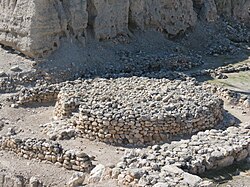High place
High places (
Hebrew Bible

From the Hebrew Bible and from existing remains a good idea may be formed of the appearance of such a place of worship. It was often on the hill above the town, as at Ramah (1 Samuel 9:12–14); there was a stele (matzevah), the seat of the deity, and a Asherah pole (named after the goddess Asherah), which marked the place as sacred and was itself an object of worship; there was a stone altar (מִזְבֵּחַ mizbeḥ "slaughter place"), often of considerable size and hewn out of the solid rock or built of unhewn stones (Exodus 20:21), on which offerings were burnt; a cistern for water, and perhaps low stone tables for dressing the victims; sometimes also a hall (לִשְׁכָּה lishkah) for the sacrificial feasts.[2]
Ancient Israelite religion was centred on these sites; at festival seasons, or to make or fulfil a vow, an Israelite might journey to more famous sanctuaries at a distance from home, but ordinarily offerings were made at the bamah of his own town.[2] The building of the Temple at Jerusalem, which under the Law of Moses had an exclusive right to offer sacrifices (Deuteronomy 12), did not stop the bamot sacrifices until Kings Hezekiah and Josiah proscribed them.
According to the
The culture of ancient Israelite sites was extremely similar to that of other Canaanite sites, with the most significant difference being the worship of Yahweh, so in spite of late Biblical references to Ur, it is probable that the Israelite federation evolved in situ in Canaan, rather than by conquest of a foreign nation, and inherited the cultural concept of high places from indigenous ancestors.[7] While Canaanites associated high places with ʼĒl, early Israelites used them for worship of Yahweh in an equivalent sense due to the conflation of Yahweh with ʼĒl. This can be seen in the frequent Biblical references to Yahweh with terms such as El, El Shaddai, Elohim, and Elyon, instead of YHWH, which was considered too holy to speak aloud. These El-based terms are likely derived from the original personal name of ʼĒl and from ancient Canaanite titles meaning "son of God," "angel of God," or "God most high." Consequently, high places can be seen as an indigenous development of both the Israelites and the Canaanites, but by the time of the composition of the Hebrew Bible's oldest texts, high places were considered avodh zereh, foreign worship associated with the Canaanite pantheon.
The prophets of the 8th century BCE assail the popular religion as corrupt and licentious and as fostering the monstrous delusion that immoral men can buy the favour of God by worship, but they make no distinction in this respect between the high places of Israel and the temple in Jerusalem. (cf. Amos 5:21 sqq.; Hosea 4:1–19; Isaiah to sqq.) Hosea stigmatizes the whole cultus as pure heathenism—Canaanite Baal-worship adopted by apostate Israel. The fundamental law in Deuteronomy 12:1–32 prohibits sacrifice at every place except the temple in Jerusalem; in accordance with this law Josiah, in 621 BCE, destroyed and desecrated the altars (bmoth) throughout his kingdom (where Yahweh had been worshipped since times before a permanent singular Temple at Jerusalem was erected) and forcibly removed their priests to Jerusalem, where they occupied an inferior rank in the temple ministry.[2]
In the prophets of the 7th and 6th centuries BCE, the word bamot connotes "seat of heathenish or idolatrous worship"; and the historians of the period apply the term in this opprobrious sense not only to places sacred to other gods but to the old holy places of Yahweh in the cities and villages of
The rule of the Law of Moses that sacrifice can be offered to Yahweh only at the Temple in Jerusalem was never fully established in fact. The Jewish military colonists in
Gallery
Modern Judaism
In Jewish
The word bimah is almost certainly derived from the Ancient Greek word for a raised platform, bema (βῆμα), with the resemblance to the Biblical word bamah being coincidental.
Eastern Orthodoxy and Eastern Catholicism
In the
The term High Place also refers to the central portion of the Holy Table, where the
See also
- Bema and bimah, elevated platform
- Peak sanctuaries
References
- JSTOR 1516934. Retrieved 2023-11-08.
- ^ a b c d e f One or more of the preceding sentences incorporates text from a publication now in the public domain: Chisholm, Hugh, ed. (1911). "High Place". Encyclopædia Britannica. Vol. 13 (11th ed.). Cambridge University Press. pp. 456–457.
- OCLC 1264795613.
- ^ OCLC 1025220665.
- OCLC 1327866765.
The ethnically mixed character of the Israelites is reflected even more clearly in the foreign names of the group's leadership. Moses himself, of course, has an Egyptian name. But so do Hophni, Phinehas, Hur, and Merari, the son of Levi.
- OCLC 1000861322.
- ISBN 978-1880317990.
- ^ "Bible side-lights from the Mound of Gezer, a record of excavation and discovery in Palestine : Macalister, Robert Alexander Stewart, 1870-1950 : Free Download, Borrow, and Streaming : Internet Archive". Internet Archive. 2023-03-25. Retrieved 2024-01-17.
- Baudissin, W.W.F. von. "Hohendienst", Protestantische Real-Encyklopädie (viii. 177–195)
- Hoonacker, Albin van(1894). Le Lieu du culte dans la legislation rituelle des Hebreux.
- Gall, August von (1898). Altisraelitische Kultstätten.
External links
- Orthodox bishop seated at the High Place
- Synthronon ancient church in Paros








